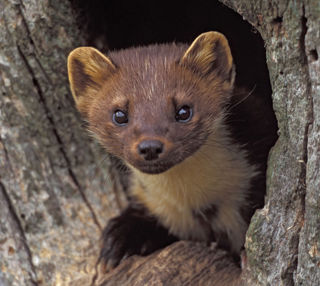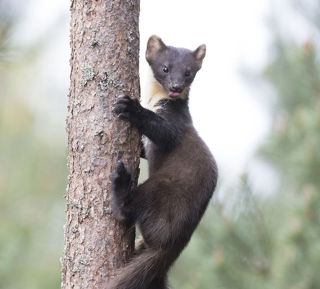South East Pine Marten restoration project
The pine marten is critically endangered in England and Wales, largely due to the widespread loss of its woodland habitat, and widespread hunting and trapping by gamekeepers. Today, they are a rare sight in the wild.
Shy, curious and agile, the pine marten is a stealthy and acrobatic predator, expertly navigating woods and trees during its foraging expeditions. Cat-sized with dense, glossy chocolate-brown fur and a distinctive creamy-yellow patch on their chest and throat. These solitary animals are mostly nocturnal but are often active at dawn and dusk during the summer.
Highly skilled climbers, pine marten spend much of their time in trees, quickly moving between branches, though they do most of their hunting on the ground. During the day, they rest on tree branches, in birds' nests, or among rocky burrows.
They have large territories, which they mark with their droppings, known as scats. These are often left in prominent spots, such as on rocks, to communicate with other pine martens.
Thanks to dedicated expertise, passion, and collaborative conservation partnerships, these elusive creatures are making a comeback. Discover how Wildwood is helping pine martens reclaim their place in the UK's woodlands.
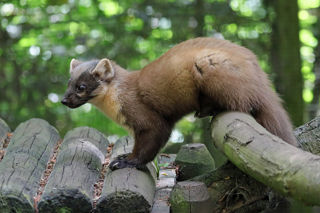
Why do pine martens need conserving?
Pine martens are one of Britain’s rarest mammals with a population estimated to be about 3,700. Humans were responsible for the decline of pine martens across the UK due to habitat destruction and persecution.
Pine martens have a long lifespan and breed slowly, only producing one or two kits every few years. Therefore, a natural recovery across Britain, resulting from the stronghold population in Scotland, will take a very long time.
There have been previous successful reintroductions of the pine marten into Wales and the Forest of Dean, and a few smaller populations remain in other places. For these populations to be genetically and geographically viable in the long-term, we need to create other populations which help to link them all together.
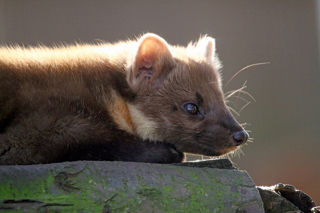
Why introduce pine martens into the South East?
This project provides an opportunity to help this native species recover in places that used to be its home.
Research has identified potential locations throughout the South East where it may be possible to reintroduce pine martens successfully. Based on this evidence, and the opportunity to connect to an existing population in Hampshire, the South East is deemed to be an ecologically viable region to restore pine martens.
Pine martens thrive in mosaic landscapes which contain large woodland complexes – and there are a number of these in the South East including Ebernoe Common, the New Forest, Ashdown Forest and the High Weald.
Average territory size for pine martens is about 10-25 km2 for males and about 5-15 km2 for females.
Pine martens are also a flagship species for habitat restoration and Nature Recovery Networks that will help to provide ecological resilience for people against climate change, and important habitat for a range of species by creating a more biodiverse and connected landscape.
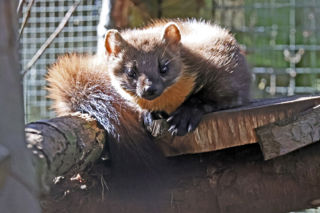
When will the project start?
The project is in the early stages of development. We are currently looking into whether it is ecologically and socially feasible to reintroduce pine martens into the South East. Although previous research shows the South East is ecologically viable, this project will also conduct research to ensure the information is up to date and still correct, as habitats and landscape change over time.
Based on best practice from previous reintroduction projects, it is vital to engage and co-develop such projects in collaboration with stakeholders to ensure the project’s success. We have established the South East Pine Marten Stakeholder Working Group, coordinated by the Project Committee (Kent Wildlife Trust, Wildwood Trust, Sussex Wildlife Trust, Ashdown Forest and Forestry England).
If the feasibility research shows that reintroduction is possible and sustainable, the stakeholder working group and committee will work together to develop a 10 year strategy to restore pine martens to the South East.
How to spot a pine marten in the wild
Pine martens are notoriously elusive, being shy and mostly nocturnal. However, Summer offers the best chance to spot them, as females and their young are more likely to forage during daylight hours.
Even if you don't see a pine marten, you might find signs of their presence:
Scats (droppings): typically dark and coiled, often containing berries. While they resemble fox scats, they have a sweet smell compared to the pungent odour of fox droppings
Tracks: their footprints have 5 toes and measure approximately 5cm x 6cm
Visiting quiet woodland areas and staying patient will improve your chances of encountering this elusive creature.
For more information about the project, please contact:
Suzanne Kynaston (suzanne@wildwoodtrust.org)
Committee organisers
Wildwood Trust
Kent Wildlife Trust
Sussex Wildlife Trust
Forestry England
Ashdown Forest
-
Conservation news
Stay updated with our conservation news, covering all our projects and efforts to protect and restore wildlife and habitats. -
Support us
Join us in making a difference - support our work to protect wildlife and restore habitats for future generations.
Stakeholder Working Group organisations
Kent High Weald Countryside Partnership, WildGenes (Royal Zoological Society Scotland), Ashdown Forest, Sussex Mammal Group, Forestry England, High Weald AONB, East Sussex County Council, Kent Mammal Group, and more.


